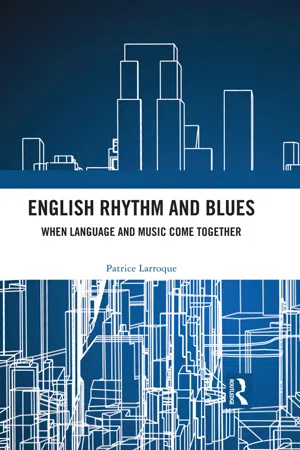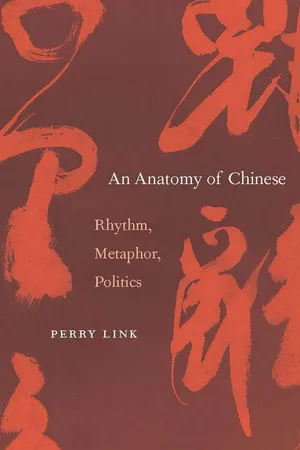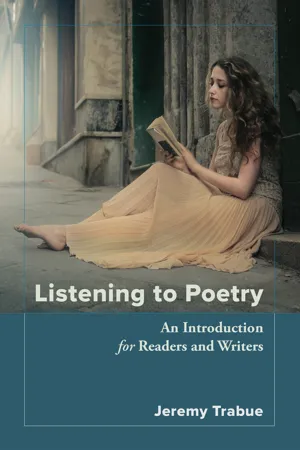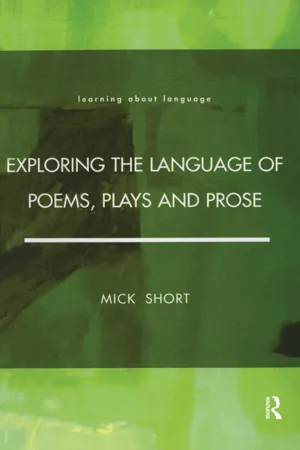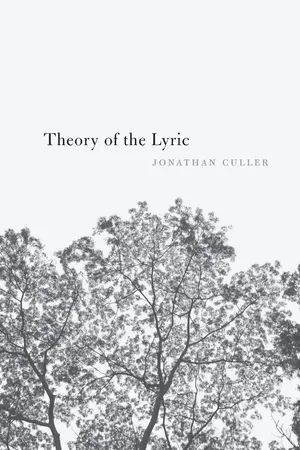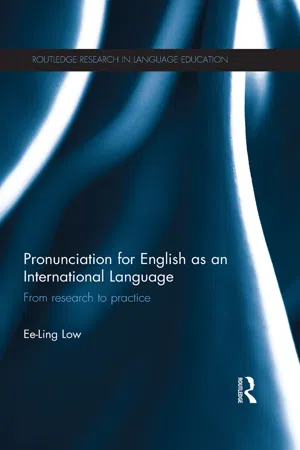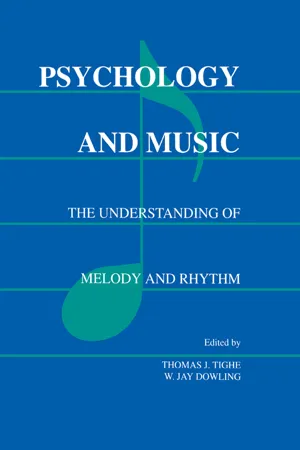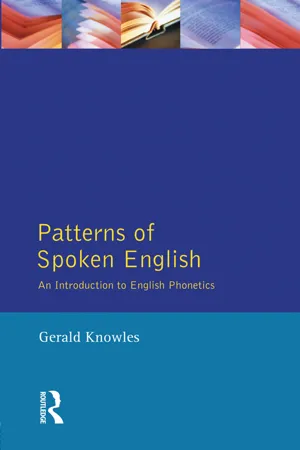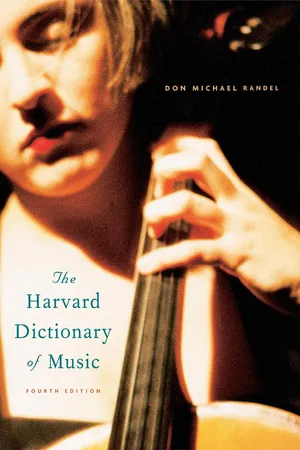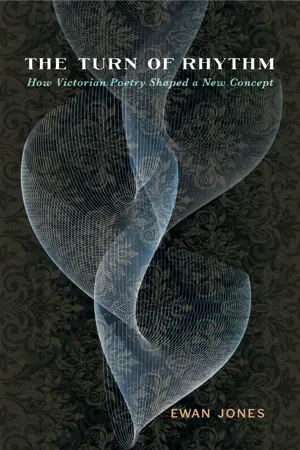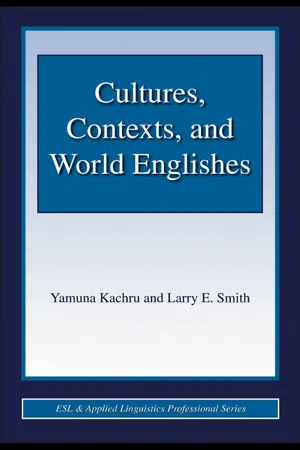Languages & Linguistics
Rhythm
Rhythm in language refers to the pattern of stressed and unstressed syllables that creates a sense of musicality and flow in speech. It is an important aspect of phonology and can vary across different languages and dialects. Rhythm plays a crucial role in the prosody of a language, influencing the overall cadence and intonation of speech.
Written by Perlego with AI-assistance
11 Key excerpts on "Rhythm"
- eBook - ePub
English Rhythm and Blues
Where Language and Music Come Together
- Patrice Paul Larroque(Author)
- 2021(Publication Date)
- Routledge(Publisher)
1 He considers meter like a dividing agent which consequently implies the existence of a whole. Conversely, he describes Rhythm as a uniting agent which actually contributes to the building of a whole and makes it progress. The progression can be organized around the periodical occurrence of stress patterns.In linguistics, the study of stress and Rhythm is part of the science of prosody. Prosody can be defined as the rules, or rather the principles, which govern duration, pitch, amplitude, frequency, loudness, and pause in vocal music. When he or she talks, a speaker naturally puts Rhythm in his speech, that is, by articulating or punctuating, by making syllables more prominent than others. In an utterance in English, strong beats are perceptually salient and generally coincide with important meaningful words; the others elements of the utterance will be unaccented.Prosody is also sensitive to syntax, morphology, the intended meaning conveyed by speech and enunciation: fluency, utterance rate, focus, etc. (cf. for example Schlüter 2005 : 17). While meter can be regarded as an inner phenomenon, as a process of measuring literary composition, Rhythm, which is linked with the perceptual aspect of speech, will apply to the different patterns and variables of spoken language.The present discussion will first be an attempt to circumscribe what the notion of Rhythm represents, its beats, tempo, and (especially African) influences. In this first part, the ideal euRhythmic structure of English is dealt with; it is, however, a structure which may present infractions. A second part is devoted to compensatory measures which aim at repairing these violations and thus restore the natural Rhythm of English speech.2.2 RhythmThe word “Rhythm” comes from Latin Rhythmus, derived from Ancient Greek ρυθμός (rhuthmos, from the verb ρεϊν, “rhein,” flow - eBook - ePub
- Perry Link(Author)
- 2013(Publication Date)
- Harvard University Press(Publisher)
1 RhythmThe stress and intonation patterns in speech, which linguists call prosody, and which I am also calling, less formally, “Rhythm,” are universal in human languages, in fact essential to them. If you hear syllables pronounced in a manner that aims at uniformity in matters of stress, pause, and pitch, the utterances will seem to you to be coming perhaps from a computer, or an imaginary alien. In any case, they will seem “not human.” Under a musicologist’s rigorous definition of “Rhythm,” all phrases in spoken language necessarily have a Rhythm, even if it is perfectly uniform or utterly random. The examples I discuss in this chapter might best be called “conventional Rhythmic patterns”; in calling them “Rhythms” I am simply using shorthand.In English we speak of syllables within words “receiving accents”—and, for longer words, which syllables get primary and secondary accents. On a scale where 1 means most stress and 4 means least, in American English the word “constitution” is usually said 2–4–1–3. If the stress pattern of “constitution” strays very far from 2–4–1–3, native speakers of American English will find that it “sounds funny.” They will get this sense instantly, whether or not they have any conscious awareness of the pattern.Stress patterns also play roles in phrases containing two words, three words, or more. For example, the name “Joey Davis,” in American English, is usually said 2–4–1–3, using the same stress pattern as “constitution.”1 Again, a native speaker would find a radical diversion from this pattern to sound extremely odd. Said in a 4–2–3–1 pattern, the name “Joey Davis” might startle you, even cause you to keep your distance from Joey the person, and you might literally find it hard to pronounce the name in a pattern like 1–4–3–2. The ways some stress patterns naturally sound better than others can cause us, without being aware that we are doing so, to choose certain word orders over others. In English, for example, if we have a one-syllable word and a two-syllable word and want to connect them with “and,” we find that it sounds better to put the one-syllable word first. “Salt and pepper” sounds better than “pepper and salt”; “bright and shiny” sounds better than “shiny and bright.”2 - eBook - ePub
Listening to Poetry
An Introduction for Readers and Writers
- Jeremy Trabue(Author)
- 2019(Publication Date)
- Chemeketa Press(Publisher)
Chapter 11 Rhythmic Language Key terms: Rhythm, accentual Rhythm, meter, accentual-syllabic Rhythm, foot, iamb, trochee, anapest, dactyl, spondee, pyrrhic, minor ionic, foot, monometer, dimeter, trimeter, tetrameter, pentameter, hexameter, heptameter, octameter, scansion From the Middle Ages until the middle of the twentieth century, no one would have dreamed of teaching or even discussing English-language poetry without a central focus on Rhythm. The Rhythm of the language was an English-language poem’s central feature for more than a thousand years! However, this is no longer true. In fact, it is common now to go through an entire introduction to poetry class—or even an entire English degree—with little more than a passing mention of Rhythm. This is tragic and foolish. Studying poetry without learning about Rhythm is like studying automotive repair without learning about motors. Rhythm is what powers the whole machine. We will not make this all-too-common mistake. Although you may find it challenging at first, the basic study of Rhythm in poetry was once nearly universal in grade schools, so you can handle it. As you’ll see, it’s no different than studying rhyme or any other element. To begin, all you need to do is get comfortable with a couple of basic concepts and learn some new terminology. This chapter builds on the “The Syllable” section from Chapter 9, so it might be a good idea to review that now. While you’re there, reread “Counting-Out Rhyme” again. We’ll take another look at that poem and how Rhythm powers it. Rhythm Basics Rhythm refers to any recognizable pattern of repetition and variation in sound or movement. You need both parts—repetition and variation—to create Rhythm. Even a very simple Rhythm like your heartbeat includes both repetition and variation. Put your hand over your heart and you will feel the Rhythm of your own body - eBook - ePub
- Mick Short(Author)
- 2018(Publication Date)
- Routledge(Publisher)
Chapter 5 Rhythm and metre in the reading of poetry5.1 What is Rhythm?
The first thing to remember is that Rhythm is not special to poetry. We can perceive Rhythm in many things (for example, music, dancing, marching, digging, swimming). Even the cycle of the year's seasons can be seen to have a Rhythm. The perception of Rhythm, then, is a fundamental human ability. All we need to feel a Rhythmic effect is to perceive a regular grouping of events in some sequence or other (e.g. of sounds, physical actions, periods of the year).However, a very regular repeated Rhythm soon becomes boring, even irritating, as anyone who buys a small child a drum soon discovers. For interesting Rhythmic effects to occur we need some underlying regularity mixed with variations. Once a regular Rhythmical beat in a tune is established, it can be made more interesting by adding cross—Rhythms or by modifying the beat in some way (e.g. by adding extra beats to, or removing them from, the basic Rhythmic pattern). Similarly, dancing can be made more fun by adding variations to the basic steps, and our perception of the annual seasonal cycle is overlaid by our differing perceptions of how long particular seasons are each year, depending upon the weather, how happy we are, and so on.5.2 Rhythm in language
Languages also have Rhythm. The underlying Rhythm of English is often said to be based on an assumption by native speakers that the amount of time between strong stresses is roughly equal.1 In English speech, each lexically full , or content word, has a major stress on one of its syllables, even if it only consists of one syllable. Single-syllable grammatical words, like prepositions (e.g. 'in', 'on') or articles ('a', 'the'), do not normally take stress, but grammatical words of more than one syllable (e.g. 'above', 'upon') will have a major stress.Let us begin with a straightforward case, a one—word variation on a traditional English proverb. You should be able to say out loud A roll ing stone gath ers the moss and make the beat clear by tapping out a regular Rhythm with your hand, the beats coinciding with roll— , stone, gath— and moss . - eBook - ePub
- Jonathan Culler(Author)
- 2015(Publication Date)
- Harvard University Press(Publisher)
The fact that Rhythmic language could to some extent replace melodic language in the affections of the young seems a sign of the profound appeal of patterned language—and perhaps a monitory lesson for modern poetry that has abandoned the more explicit forms of linguistic patterning, including meter and vigorous Rhythm. In the case of pop music our sense of the success, of the catchiness, the memorability of a song, is at least as much dependent on Rhythm as on meaning, since words of songs we repeat and those we love (not necessarily the same—such is the seduction of Rhythm) can be wholly banal or even unintelligible. A greater foregrounding of Rhythm as central to lyric might enable the teaching of poetry to regain some of the ground lost in recent years and also might lead to a different sort of poetics. One could thus imagine an approach more connected with evaluation, which has not been central to literary studies recently: What works and what doesn’t? What engages our attention, our corps de jouissance —to use Barthes’s term—and what does not? For such a poetics an important part of the teaching of poetry would be accustoming students to hearing and experiencing the Rhythms of traditional verse—they have a surprisingly hard time hearing iambic pentameter without the practice of recitation, for instance, though they fare much better with four-beat Rhythms. 3 - eBook - ePub
Pronunciation for English as an International Language
From research to practice
- Ee-Ling Low(Author)
- 2014(Publication Date)
- Routledge(Publisher)
8 Rhythm DOI: 10.4324/9781315814131-8The preceding chapter provided some details about stress in isolated words and basic facts about stress in sentences. In that chapter we looked at (1) syllables that receive primary stress; (2) syllables that receive secondary stress; and (3) syllables that are unstressed. We also looked at sentence stress, which tends to fall on syllables of content words. Recall that earlier in this book, particularly in Chapter 6 , we examined the concepts and examples of strong forms and weak forms, vowel reduction, sound linking and assimilation. These chapters have in fact provided us with some essential information about how differences exist between stresses that occur in individual words and those that occur in connected speech, and how these aspects operate at sentence level. This chapter will put these pieces of essential information together and take it one step further and look beyond them at the collaborative role they play in shaping the Rhythm of English speech.What is Rhythm?
Rhythm arises from the occurrence of similar or ‘like’ events. For example, the ticking of a clock and the heartbeats of a healthy person are Rhythmic because they involve an alternating strong beat followed by a weak beat in a pattern that recurs. The concept of musical Rhythm is perhaps even more established than speech Rhythm and would be an appropriate starting point to talk about the concept of Rhythm. In music, strong beats separate notes into bars and, depending on the timing to which a piece of musical composition has been organised, the number of strong and weak beats in each bar varies. For example, in 3/4 timing, each bar will have the equivalent of three whole beats, likewise, in 2/4 timing, each bar will have two whole beats and so on. In speech, however, strong beats separate speech segments into feet. A foot comprises one stressed syllable up to but not including the next stressed syllable. In the example sentence I | WENT to see| JANE, we see evidence of the presence of just one foot marked below: - eBook - ePub
Psychology and Music
The Understanding of Melody and Rhythm
- W. Jay Dowling, Thomas J. Tighe(Authors)
- 2014(Publication Date)
- Psychology Press(Publisher)
Gabrielsson, 1986 ). Furthermore, Rhythm is used as a concept in many contexts other than music and dance, for example, Rhythm in poetry, speech, architecture, drama, film, athletics, body movements, biological processes (heart Rhythm, brain Rhythms), and so on. This diversity is another testimony of the importance of Rhythm. At the same time, however, it makes the task of definition even more difficult. These other fields are left outside the present discussion except for such body movements that have a natural connection to music.In the following we adopt a working definition of musical or auditory Rhythm as being “a response to music or sound sequences of certain characteristics, comprising experiential as well as behavioral aspects.” By analyzing and investigating these aspects of the Rhythm response (mainly the experiential), and by studying the characteristics of music or sound sequences that elicit Rhythm responses of various kinds, one should at least come somewhat closer to an understanding of this elusive phenomenon—but it seems wise to keep the aspirations at a low level. Maybe even part of the fascination we feel concerning Rhythm (and music) is due to this elusiveness, that the phenomenon defies our usual analytic tools and keeps showing other sides of itself when we think we have caught some of them into our dissecting net.Before that perhaps some qualifying statements are in order. A music expert may find some of the foregoing statements about the relationships between various musical elements simplistic and incomplete. He or she may also point out that there is in fact also music without Rhythm, not the least in avant-garde music from our own century, and would perhaps ask to what degree the discussion is applicable to music outside the areas of Western art music and popular music focused here. At this point we can only agree and answer that Rhythm is a very large subject, and this chapter is bound to be short. Hopefully the following pages will tell a story with many more nuances and inspire one to further reading of other, more comprehensive texts. - eBook - ePub
Patterns of Spoken English
An Introduction to English Phonetics
- Gerald Knowles(Author)
- 2014(Publication Date)
- Routledge(Publisher)
CHAPTER 5RhythmThe use of the word ‘Rhythm’ as the title for this chapter is likely to conjure up a variety of images relating to different Rhythmical phenomena. We talk of the ‘Rhythm’ of the tides and the seasons, the ‘Rhythm’ of the heart and the pulse, the ‘Rhythm’ of dance and music, and even of the ‘Rhythm’ of architecture. These are powerful metaphors, and what they have in common is the regular repetition of some kind of pattern, some parts of which are ‘strong’ and others ‘weak’, and some ‘long’ and others ‘short’.However, just because a pattern is regularly repeated in non-speech Rhythms it does not follow that speech Rhythms must also consist of regular patterns. We are using the term ‘Rhythm’ in a different, specialized sense, and the ground of the metaphor shifts from one sense to another. We shall investigate patterns of long and short, and strong and weak in speech; and if any kind of regularity turns up it is an added bonus, not something to be expected as a matter of course.What is loosely called a ‘long’ phoneme or syllable is more precisely ‘lengthenable’; the speaker may not actually make it very long on every occasion, but it can in principle be drawn out significantly beyond the minimum time needed to produce it. A ‘short’ phoneme or syllable cannot be lengthened in this way. The long/short distinction is not stable over time, however, and historical developments can recategorize a ‘short’ item to a pattern more like a ‘long’ one. Now unless we are very careful, we are going to be discussing short ‘long’ items and long ‘short’ items, and this is a recipe for confusion. Instead of ‘length’, let us use the term WEIGHT. HEAVY items are lengthenable, LIGHT items are not. ‘Heavy’ and ‘light’ are extremes on a continuum, and some items are intermediate. ‘Heavy’ items are conventionally marked with the macron (–) and ‘light’ items with the breve ()̆.There are several levels of Rhythm in speech. The lowest level concerns patterns of duration among segments in the syllable. The next level is that of syllables in the accent group. Accent groups combine to form longer phrases, and phrases combine to form the larger chunks of discourse. - eBook - ePub
- Don Michael Randel, Don Michael Randel(Authors)
- 2003(Publication Date)
- Belknap Press(Publisher)
(laya) and Rhythm (in the sense of “a Rhythm”) also imply at least two layers of motion even where only one is explicit. “Fast,” “medium,” and “slow” in musical time exist on a continuum, and they are relative proximately not only to one another but also ultimately to some sort of biological sense of a normal pace against which they are perceived; the heartbeat at rest, the breath rate at ease, or a comfortable walking pace have all been considered manifestations of that norm. Similarly, Rhythmic patterns are necessarily separated one from another in some way and usually are also differentiated internally. The means of separation and differentiation are various—by shorter and longer durations between attacks, by softer and louder dynamic stress, by thinner and thicker textural density, by simple and complex (or “consonant” and “dissonant”) simultaneous sonorities, by lower and higher pitch, by duller and sharper percussive sound, or by any combination thereof—but there is always at least a bipolar contrast, at least two structural layers.As may be seen from several of the foregoing continua, Rhythm is necessarily a part of the pitch and textural aspects of music as well, and one can speak of durational Rhythm, accentual Rhythm, textural Rhythm, harmonic Rhythm, melodic Rhythm, or timbral Rhythm, depending on which aspect is to the fore in any particular context. But a closer look shows that a separable sense of durational or accentual contrast is entailed in the pitch and texture continua in any case. Alternations in any of the last five of the six continua above (e.g., louder versus softer) will serve as a rough measure of time elapsed between successions on each level (e.g., between successive louds); thus, temporal duration is often a part of accentual and other Rhythmic parameters. Similarly, certain extremes on any of the textural and pitch continua will sound out more prominently—being strikingly more or less complex in frequency structure or nearer to one end or the other of the pitch continuum—so that even in contexts without overt durational or dynamic contrast, accentual highlighting is often present. - eBook - ePub
Victorian Literature and Culture Series
How Victorian Poetry Shaped a New Concept
- Ewan Jones, Ewan J. Jones(Authors)
- 2023(Publication Date)
- University of Virginia Press(Publisher)
Chapter 1
Stuttering Rhythms
“An Instinctive Sense of Rhythmus”
If anglophone culture by 1779 was yet to possess a developed concept of Rhythm, it was not for want of understanding of its nature or effects. In fact, argued Joshua Steele, in the expanded second edition to his Prosodia Rationalis, which appeared that year, we grasp the phenomenon so intuitively that we scarcely need name it:Our animal existence being regulated by our pulse, we seem to have an instinctive sense of Rhythmus as connected with, and governing, all sounds and all motions; whence it follows, that we find all people feel the effects of Rhythmus, as they do those of light and warmth derived from the Sun; so that, without searching for the reason, it has generally been passed over as a first principle, or self-evident truth. The swing of the arm, and other such motions, made by public speakers, are derived from their instinctive sense of Rhythmus and are, in effect, beating time to their orations. Also cursing, swearing, and many other unmeaning words, so frequently interwoven in common discourse, are merely expletives to fill the measure, and to round each Rhythmical period.1Steele’s Rhythmical inventory is at first glance hardly novel. Saint Augustine’s De Musica similarly extended precise numerus to the beating pulse, speaking tongue, and breathing mouth: “The soul produces the numbers we find in the beat of the veins.”2 Plotinus, Athanasius Kircher, and Leibniz offer comparable numerological cosmologies.Yet Steele’s appeal to the “self-evident truth” of Rhythm ultimately veers from such august precursors. Augustine’s numbers sought to transcend the “sensible traces of music,” so as to discover “the real places . . . free from all body” [ubi ab omni corpore aliena est].3 Prosodia Rationalis instead sketches something like a proto-phenomenology of physical tics and vocal exclamation that includes involuntary bodily processes (the “instinctive” swing of the orator’s arm), vulgarity (“cursing, swearing”), and semantic vacuity (“unmeaning words”). This physiological component tends to go unnoticed in the many scholarly accounts that perceive Prosodia Rationalis, correctly, as a watershed in our understanding of linguistic structure. T. S. Omond and Paul Fussell have demonstrated the scale of Steele’s achievement in liberating anglophone prosody from a hidebound adherence to classical “quantity.”4 David Crystal detects in his vocal “glides” the first systematic elaboration of what linguistics has since learned to call intonational contours.5 - eBook - ePub
- Yamuna Kachru, Larry E. Smith(Authors)
- 2008(Publication Date)
- Routledge(Publisher)
By different ways of speaking is meant use of a different set of rules regarding Rhythmic patterns, word-order, and other devices to indicate meanings such as what is being talked about, emphasized, or related to preceding utterances. Recent research in language use in reallife social contexts such as job interviews, court cases, and doctor–patient interactions, in addition to normal conversational exchanges, has shown that different speech communities use language differently. In fact, different ethnic groups living in the same speech community use a shared language quite differently (Tannen, 1984). For instance, African Americans in the USA use English in different speech functions as compared to other Americans and use talk for different purposes (e.g. Goodwin, 1990; Labov, 1972a, Ch. 8; Mitchell-Kernan, 1972, 1973; Morgan, 1996; Schilling-Estes, 2000; Smitherman, 1995). Furthermore, speakers of different ethnic communities signal their intentions in inter-ethnic communication in a way which is sufficiently different to cause problems for listeners who do not share their ethnic background (e.g. Hansell and Ajirotutu, 1982; Hecht et al., 1992; Mishra, 1982, among others). A much more serious problem is caused when participants in an interaction come from different speech communities and use a common language such as English in significantly different ways. RhythmIC PATTERNS There are patterns of stress, pitch, and loudness that convey specific meanings. Some are universals, e.g. a high level of pitch and increased loudness conveys excitement or signals new information (Chafe, 1972). Others are culture-specific. For example, loudness may convey emphasis in one culture, but aggression in another
Index pages curate the most relevant extracts from our library of academic textbooks. They’ve been created using an in-house natural language model (NLM), each adding context and meaning to key research topics.
Explore more topic indexes
Explore more topic indexes
1 of 6
Explore more topic indexes
1 of 4
